Overview
Here is a quick summary of the versions in my collection:
- 10-tooth Z-tooth cam (round toe).
(#1503)
- 11-tooth Z-tooth cam (sharp toe).
(#2096, 3593)
- 12-tooth Z-tooth cam.
(#2097, 3594)
- 11-tooth Z-tooth cam (both cam sides cut).
(#1504)
- 11-tooth Z-tooth cam. Adds top hole to shell.
(#3534)
- 13-tooth Z-tooth cam. Concave cam face.
(#1, 212, 213, 1585, 2100,, 2397)
- 16-tooth Z-tooth cam.
(#3674)
- Clog logo rotated to vertical orientation.
(#2304, 2321, 3663)
- 14-tooth Z-tooth cam. Hole in cam replaces the pin.
(#1524, 2123)
- 13-tooth Z-tooth cam. Changed cam rivets.
(#2, 1586)
- 14-tooth Z-tooth cam. Add rope size stamps.
(#2, 1586)
- Change to cast conical-toothed cam.
(#1909)
- Eliminate rope size stamps.
(#197. 1544)
- New shell design.
(#2122)
- Anodized shell.
(#3, 1963, 2124, 3461, 3634)
- Stamped lot number.
(#2004, 3592)
- Round rivets.
(#2121)
- Adds a cam stop.
(#1512, 1904, 1964, 2005)
- Second bottom hole without cam stop.
(#1584)
- Cam rivet changed to headed style.
(#1557, 2006)
- Second bottom hole with cam stop.
(#233)
- Cam retained by retaining ring.
(#196)
The cams on the early versions show small variations that may have reflected minor design or production changes, but some of them may just be artifacts of loose manufacturing tolerances.
I am not certain about the ordering of the later (black) versions. Both single and double lower hole versions appear both with and without cam stops, and both with and without the older rivet design. The single and double lower hole versions may have been contemporaneous rather than sequential.
[ Top
| Versions B1 & B2
| Version C
| Version D
| Version E
| Version F
| Version G
| Version H
| Version I
| Version J
| Version K
]
[ Version L
| Version M
| Version N
| Version O
| Version P
| Version Q
| Version R
| Version R (2nd)
| Version S
| Version T
| Version U
| Version V
| Return to E.C. Ascenders
]
Version A
(#1503)
Technical Details
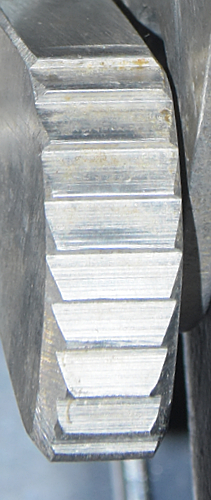 I acquired my Clog, Version A from Paul Gough in 2009.
I acquired my Clog, Version A from Paul Gough in 2009.
Version A is 102 mm. tall, 84 mm. wide, 29 mm. thick, and weighs 164 g. The ascender shell is a roughly quadrilateral shaped piece of unfinished 4 mm. thick aluminum bent to form a rope groove on one side and to hold the cam pivot on the other. The rope groove is 15 mm. in diameter, but the sides of the groove are distinctly nonparallel. The main attachment point is a 14.6 mm. hole located directly below the cam pivot. The cam is solid aluminum and supports a post provided to make opening the cam easier. The side of the cam adjacent to the shell has the center milled out to reduce contact with the shell. The 10 cam teeth are formed by milling transverse grooves across the rope bearing surface, creating a z-shaped tooth profile. The cam radius, measured from the pivot, increases from 42 to 57 mm. over an angle of 37°, giving a 24° cam angle, but it does not look like Clog followed an equiangular spiral. The cam and cam spring are mounted on a crude solid rivet. The pivot is centered 52 mm. from the inside of the rope groove. There is no cam safety.
The words "CLOG" and "MADE IN WALES" are stamped on the inner shell surface.
When I first saw the two ascenders that Paul had, I assumed that they were a pair and that the only difference between them and Version F was the single hole in the shell. When they arrived, I realized that they had older cam designs, and different ones as well. The z-shaped teeth are straight, not concave as in Version F. On this ascender, the toe of the cam is well-rounded.
|
 |
I am looking for a right-handed ascender of this version. If you can help me obtain one,
please email me. |
|
[ Top
| Version A
| Version C
| Version D
| Version E
| Version F
| Version G
| Version H
| Version I
| Version J
| Version K
]
[ Version L
| Version M
| Version N
| Version O
| Version P
| Version Q
| Version R
| Version R (2nd)
| Version S
| Version T
| Version U
| Version V
| Return to E.C. Ascenders
]
Versions B1 & B2
(#2096/3593)
Technical Details
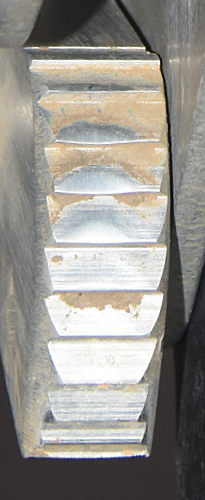 I acquired my left-hand Clog, Version B1 in 2017 as part of Bob Thrun’s collection. Sam Johnson sent me right-hand Version B2 in 2023
I acquired my left-hand Clog, Version B1 in 2017 as part of Bob Thrun’s collection. Sam Johnson sent me right-hand Version B2 in 2023
Versions B1 & B2 is 102 mm. tall, 84 mm. wide, 29 mm. thick, and weighs 164 g. The rope channel is 15 mm. wide. The shell is essentially the same as the Version A shell, mirrored to make a right-hand ascender. The cam is different. There are 11 cam teeth formed by milling transverse grooves across the rope bearing surface, creating a z-shaped tooth profile. The bottom tooth is partially formed and sharp enough to cut. The cam radius, measured from the pivot, increases from 41 to 57 mm. over an angle of 33°, giving a 31° cam angle, but Clog did not follow an equiangular spiral. Both sides of the cam are cut away like the rear side of the Version A cam.
The words "CLOG" and "MADE IN WALES" are stamped on the inner shell surface. On Version B1, these are stamped near the top of the shell in larger letters, while for Version B2 they are stamped in smaller letters near the bottom, with "CLOG" inside an ellipse.
The top five teeth are nearly full width. The last tooth, on the toe, is sharp enough to cut skin.
[ Top
| Version A
| Versions B1 & B2
| Version D
| Version E
| Version F
| Version G
| Version H
| Version I
| Version J
| Version K
]
[ Version L
| Version M
| Version N
| Version O
| Version P
| Version Q
| Version R
| Version R (2nd)
| Version S
| Version T
| Version U
| Version V
| Return to E.C. Ascenders
]
Version C
(#2097)
Technical Details
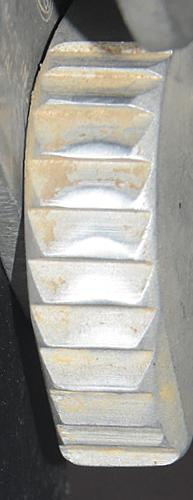 I acquired my right-hand Clog, Version C in 2017 as part of Bob Thrun’s collection. Sam Johnson sent me a left-hand Version C in 2023
I acquired my right-hand Clog, Version C in 2017 as part of Bob Thrun’s collection. Sam Johnson sent me a left-hand Version C in 2023
Version C is 103 mm. tall, 82 mm. wide, 30 mm. thick, and weighs 165 g. The shell is essentially the same as the Version A shell, mirrored to make a right-hand ascender. The rope channel is 15 mm. wide. The cam has 12 cam teeth formed by milling transverse grooves across the rope bearing surface, creating a z-shaped tooth profile. The cam radius, measured from the pivot, increases from 39 to 56 mm. over an angle of 40°, giving a 27° cam angle, but Clog did not follow an equiangular spiral.
The words "CLOG" inside an ellipse and "MADE IN WALES" are stamped on the inner shell surface.
Now with 12 teeth.
[ Top
| Version A
| Versions B1 & B2
| Version C
| Version E
| Version F
| Version G
| Version H
| Version I
| Version J
| Version K
]
[ Version L
| Version M
| Version N
| Version O
| Version P
| Version Q
| Version R
| Version R (2nd)
| Version S
| Version T
| Version U
| Version V
| Return to E.C. Ascenders
]
Version D
(#1504)
Technical Details
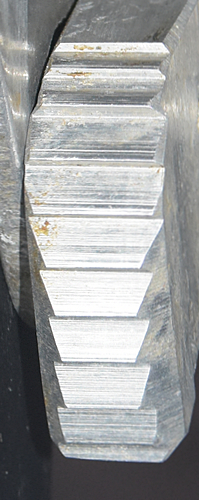 I acquired my Clog, Version D from Paul Gough in 2009.
I acquired my Clog, Version D from Paul Gough in 2009.
Version D is 102 mm. tall, 84 mm. wide, 29 mm. thick, and weighs 164 g. The shell is essentially the same as the Version A shell, mirrored to make a right-hand ascender. The cam is different. There are 11 cam teeth formed by milling transverse grooves across the rope bearing surface, creating a z-shaped tooth profile. The cam radius, measured from the pivot, increases from 34 to 53 mm. over an angle of 43°, giving a 30° cam angle, but Clog did not follow an equiangular spiral. Both sides of the cam are cut away like the rear side of the Version A cam.
The words "CLOG" and "MADE IN WALES" are stamped on the inner shell surface.
This appears to be a later cam design than the one used on Version A. The side cut on the back of the cam is larger than in Version A, and so the top teeth are narrower than the next two below.
|
 |
I am looking for a left-handed ascender of this version. If you can help me obtain one,
please email me. |
|
[ Top
| Version A
| Versions B1 & B2
| Version C
| Version D
| Version F
| Version G
| Version H
| Version I
| Version J
| Version K
]
[ Version L
| Version M
| Version N
| Version O
| Version P
| Version Q
| Version R
| Version R (2nd)
| Version S
| Version T
| Version U
| Version V
| Return to E.C. Ascenders
]
Version E
(#3534)
Technical Details
 I acquired my Clog, Version E from Sam Johnson in 2022.
I acquired my Clog, Version E from Sam Johnson in 2022.
Version E is 103 mm. tall, 84 mm. wide, 29 mm. thick, and weighs 164 g. The shell is essentially the same as the Version A shell, mirrored to make a right-hand ascender. The rope channel is 14 mm. wide. The cam axle is centered 55 mm. from the inside of the rope channel. This version has a 13 mm. hole located above the cam. It serves as an upper attachment point.
The cam has 11 teeth formed by milling transverse grooves across the rope bearing surface, creating a z-shaped tooth profile. The cam radius, measured from the pivot, increases from 33 to 56 mm. over an angle of 42°, giving a 31° cam angle, but Clog did not follow an equiangular spiral.
An oval with "CLOG" inside is stamped above the upper hole, and "MADE IN WALES" is stamped on the inner shell surface.
The upper attachment hole provides additional flexibility that is useful with some climbing systems.
|
 |
I am looking for a left-handed ascender of this version. If you can help me obtain one,
please email me. |
|
[ Top
| Version A
| Versions B1 & B2
| Version C
| Version D
| Version E
| Version H
| Version I
| Version J
| Version K
]
[ Version L
| Version M
| Version N
| Version O
| Version P
| Version Q
| Version R
| Version R (2nd)
| Version S
| Version T
| Version U
| Version V
| Return to E.C. Ascenders
]
Version F
(#1, 212, 213, 1585, 2100, 2397)
Technical Details
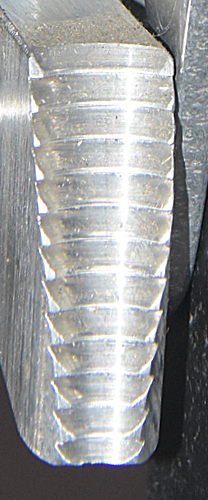 I acquired this pair at Eiselin Sport in Bern, Switzerland in 1981, two more from Craig Kubanoff in 2007 (one given to Артём Бабин), and one from Jon Marshall in 2012 (traded to Sam Johnson for #3534). I acquired another pair in 2017 as part of Bob Thrun’s collection, and Rick Banning gave me another pair in 2019.
I acquired this pair at Eiselin Sport in Bern, Switzerland in 1981, two more from Craig Kubanoff in 2007 (one given to Артём Бабин), and one from Jon Marshall in 2012 (traded to Sam Johnson for #3534). I acquired another pair in 2017 as part of Bob Thrun’s collection, and Rick Banning gave me another pair in 2019.
The pair consists of a left-handed and a right-handed ascender. Each ascender is 103 mm. high, 82 mm. wide, 25 mm. thick (with a post extending to 35 mm.), and weighs 165 grams. The ascender shell is a roughly quadrilateral shaped piece of unfinished 4.2 mm. thick aluminum bent to form a rope groove on one side and to hold the cam pivot on the other. The rope groove is 15.2 mm. in diameter, but the sides of the groove are distinctly nonparallel. The main attachment point is a 15 mm. hole located directly below the cam pivot. A second 15 mm. hole located above the cam serves as an upper attachment point. The cam is solid aluminum and supports a post provided to make opening the cam easier. The 13 cam teeth are formed by milling transverse grooves across the rope bearing surface, creating a concave z-shaped tooth profile. The cam radius, measured from the pivot, increases from 48 to 59 mm. over an angle of 34°, giving a 17° cam angle. The cam and cam spring are mounted on a crude solid rivet. The pivot is centered 52 mm. from the inside of the rope groove. There is no cam safety.
The inner shell surface is stamped with "CLOG" and "WALES inside an oval.
In general this is a crude ascender, typical of many products of the 1960’s but not up to current workmanship standards. The cam tooth design is not as mud-tolerant as the conical design used on most eccentric cam ascenders. The ascender is easily opened with either hand. The ascender must be attached to the harness by a carabiner through the bottom attachment hole. Once attached, the carabiner obstructs the cam, preventing it from opening. This eliminates the need for an independent cam safety.
Clog eliminated carabiner attachment holes from their handled expedition ascenders because of two cases of carabiner failure. These were caused by sideways gate loading on carabiners lodged incorrectly in the attachment hole (D. Moorhouse, Clog Climbing Gear, Off Belay #30, Dec. 76, pp. 54-55). This could happen with this ascender also, as well as many other brands. I caution against using carabiners for attaching slings to ascenders.
[ Top
| Version A
| Versions B1 & B2
| Version C
| Version D
| Version E
| Version F
| Version H
| Version I
| Version J
| Version K
]
[ Version L
| Version M
| Version N
| Version O
| Version P
| Version Q
| Version R
| Version R (2nd)
| Version S
| Version T
| Version U
| Version V
| Return to E.C. Ascenders
]
Version G
(#3674)
Technical Details
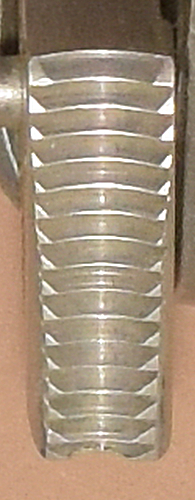 I acquired this pair from Sarah Sherman in 2025.
I acquired this pair from Sarah Sherman in 2025.
The Clog, Version G is 103 mm. tall, 83 mm. wide, 31 mm. thick, and weighs 164 g. The rope channel is 15 mm. wide. The cam axle is centered 54 mm. from the inside of the rope channel. The cam radius, measured from the axle axis, increases from 49 to 59 mm. over an angle of 36°, giving a 17° cam angle. The tooth pattern is (Z)^16, circular cam.
The pair consists of a left-handed and a right-handed ascender. Each ascender is 103 mm. high, 83 mm. wide, 25 mm. thick (with a post extending to 31 mm.), and weighs 164 grams. The ascender shell is a roughly quadrilateral shaped piece of unfinished 4.2 mm. thick aluminum bent to form a rope groove on one side and to hold the cam pivot on the other. The rope groove is 15 mm. in diameter, but the sides of the groove are distinctly nonparallel. The main attachment point is a 15 mm. hole located directly below the cam pivot. A second 15 mm. hole located above the cam serves as an upper attachment point. The cam is solid aluminum and supports a post provided to make opening the cam easier. The 16 cam teeth are formed by milling transverse grooves across the rope bearing surface, creating a concave z-shaped tooth profile. The cam radius, measured from the pivot, increases from 49 to 59 mm. over an angle of 36°, giving a 17° cam angle. The cam and cam spring are mounted on a crude solid rivet. The pivot is centered 54 mm. from the inside of the rope groove. There is no cam safety.
The inner shell surface is stamped with "CLOG" and "WALES inside an oval.
The only significant difference between this version and Version F is that the number of teeth on the cam was increased from 13 to 16 teeth. The top tooth on the left-hand ascender is incompletely formed, while the right-hand ascender cam has a full top tooth.
[ Top
| Version A
| Versions B1 & B2
| Version C
| Version D
| Version E
| Version F
| Version G
| Version I
| Version J
| Version K
]
[ Version L
| Version M
| Version N
| Version O
| Version P
| Version Q
| Version R
| Version R (2nd)
| Version S
| Version T
| Version U
| Version V
| Return to E.C. Ascenders
]
Version H
(#2304, 2321, 3663)
Technical Details
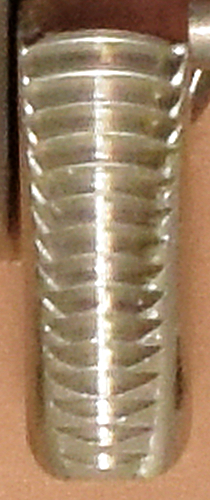 I acquired my first pair of Clog, Version H ascenders from Bill Liebman in 2017. I obtained another right-hand ascender from John Replinger later that year, and a new old stock pair from MDSA Vintage and Modern Store in 2025.
I acquired my first pair of Clog, Version H ascenders from Bill Liebman in 2017. I obtained another right-hand ascender from John Replinger later that year, and a new old stock pair from MDSA Vintage and Modern Store in 2025.
Version H is 104 mm. tall, 82 mm. wide, 35 mm. thick, and weighs 165 g. The rope channel is 15 mm. wide. The cam radius increases from 49 to 59 mm. over an angle of 36°, giving a 17° cam angle. The tooth pattern is (Z)^16, circular cam.
The inner shell surface is stamped with "CLOG" and "WALES inside an oval.
This ascender, like Version G, has 16 milled z-shaped teeth, while other versions in my collection with the pin cam have 10, 11, 12, or 13, and the versions with the hole with the hole have 13 or 14. I wonder, were these changes were intentional or were they just normal variations due to hand machining?
[ Top
| Version A
| Versions B1 & B2
| Version C
| Version D
| Version E
| Version F
| Version G
| Version H
| Version J
| Version K
]
[ Version L
| Version M
| Version N
| Version O
| Version P
| Version Q
| Version R
| Version R (2nd)
| Version S
| Version T
| Version U
| Version V
| Return to E.C. Ascenders
]
Version I
(#1524, 2123)
Technical Details
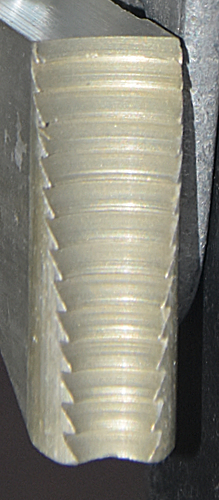 I acquired a pair of Clog Version I ascenders used on eBay from Steve Sirrs in 2009. I acquired another in 2017 as part of Bob Thrun’s collection.
I acquired a pair of Clog Version I ascenders used on eBay from Steve Sirrs in 2009. I acquired another in 2017 as part of Bob Thrun’s collection.
Version I is 103 mm. tall, 84 mm. wide, 25 mm. thick, and weighs 162 g. The rope channel is 14 mm. wide. The ascender shell is identical to that in Version F; only the cam assembly differs. The revised cam appears to be made of steel, the pin is eliminated, and a finger hole serves both to lighten the cam and to ease operating the cam. The side of the cam adjacent to the shell is relieved by milling. The cams are well made, but machining burrs at the edges were not removed. The cam radius increases from 50 to 58 mm. over an angle of 35°, giving a 15° cam angle. The tooth pattern is (Z)^14, circular cam. The cam is mounted with a round-head rivet.
The inner shell surface is stamped with "CLOG" and "WALES inside an oval.
This ascender is 3 g. lighter than Version F, and elimination of the cam pin reduces the thickness by 10 mm.
This version retains the crude shell of the earlier versions, but cam is better made.
I do not like using a bell rivet expanded into countersunk holes in the shell as the cam axle. I've never seen one of the bell rivets fail in use, but I would prefer to see rivets with more substantial heads.
[ Top
| Version A
| Versions B1 & B2
| Version C
| Version D
| Version E
| Version F
| Version G
| Version H
| Version I
| Version K
]
[ Version L
| Version M
| Version N
| Version O
| Version P
| Version Q
| Version R
| Version R (2nd)
| Version S
| Version T
| Version U
| Version V
| Return to E.C. Ascenders
]
Version J
(#2, 1586)
Technical Details
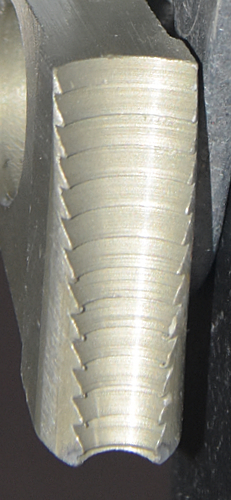 I acquired this pair along with Version F, and another pair from and one from Jon Marshall in 2012.
I acquired this pair along with Version F, and another pair from and one from Jon Marshall in 2012.
Each ascender is 103 mm. high, 82 mm. wide, 25 mm. thick, and weighs 153 grams. The rope channel is 14 mm. wide. The cam radius increases from 46 to 58 mm. over an angle of 36°, giving a 21° cam angle. The tooth pattern is (Z)^13. Both sides of the cams are relieved by milling. The cams are well made, but machining burrs at the edges were not removed. The cam radius, measured from the pivot, increases from 48 to 59 mm. over an angle of 34°, giving a 21° cam angle. The cam is mounted with a semi-tubular rivet, which is expanded into a countersunk hole in the shell.
The inner shell surface is stamped with "CLOG" and "WALES inside an oval.
Milling both sides of the cam reduces the weight by 12g. compared to Version J. The countersunk cam rivet, however, seems less secure than the round-head rivet used on Version I.
[ Top
| Version A
| Versions B1 & B2
| Version C
| Version D
| Version E
| Version F
| Version G
| Version H
| Version I
| Version J
]
[ Version L
| Version M
| Version N
| Version O
| Version P
| Version Q
| Version R
| Version R (2nd)
| Version S
| Version T
| Version U
| Version V
| Return to E.C. Ascenders
]
Version K
(#3524)
Technical Details
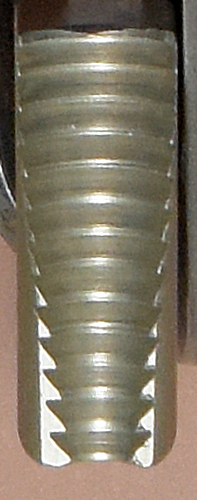 I acquired this pair of ascenders from Adventure Outdoors in 2022.
I acquired this pair of ascenders from Adventure Outdoors in 2022.
Version K is 104 mm. tall, 82 mm. wide, 25 mm. thick, and weighs 148 g. The rope channel is 15 mm. wide. The cam axle is centered 53 mm. from the inside of the rope channel. The cam radius, measured from the axle axis, increases from 47 to 59 mm. over an angle of 36°, giving a 20° cam angle. The tooth pattern is (Z)^14. Both sides of the cams are relieved by milling. The cams are well made. The cam radius,The cam axle is centered 53 mm. from the inside of the rope channel. The cam is mounted with a bell rivet, which is expanded into a countersunk hole in the shell.
The inner shell surface is stamped with "CLOG" and "WALES inside an oval, "9-11 mm" and "KERNMANTEL."
This version adds the stamped rope size information. It also has 14 cam teeth instead of 13 as found on Version J.
[ Top
| Version A
| Versions B1 & B2
| Version C
| Version D
| Version E
| Version F
| Version G
| Version H
| Version I
| Version J
| Version K
]
[ Version M
| Version N
| Version O
| Version P
| Version Q
| Version R
| Version R (2nd)
| Version S
| Version T
| Version U
| Version V
| Return to E.C. Ascenders
]
Version L
(#1909)
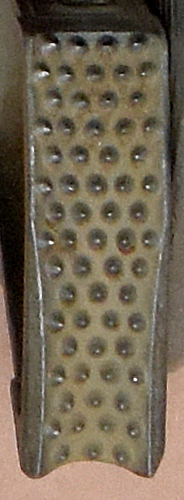 Technical Details
Technical Details
I acquired a left-hand ascender from Jean Slade in 2012. The Clog,
Version L is 103 mm. high, 1 mm. wide, 24 mm. thick, and weighs 152 grams. The rope channel is 15 mm. wide. The cam axle is centered 55 mm. from the inside of the rope channel. The cam is a skeletonized steel casting with a (4.5)^4(4.3)^4 conical tooth pattern. The teeth axes are perpendicular to the cam face. The cam radius, measured from the pivot, i43 to 57 mm. over an angle of 41°, giving a 22° cam angle. The cam and cam spring are mounted on a semi-tubular rivet. The pivot is centered 55 mm. from the inside of the rope channel. There is no cam safety. The cam is mounted with a bell rivet, which is expanded into a countersunk hole in the shell.
The inner shell surface is stamped with "CLOG" and "WALES inside an oval, "9-11 mm" and "KERNMANTEL." The word "CLOG" is cast in the upper cam surface.
This version retains the crude shell of the earlier versions, but the new conical-toothed steel cam is a definite improvement. The steel cam is more wear resistant than the aluminum cam in the previous versions. The new teeth grip better under adverse conditions.
|
 |
I am looking for a right-handed ascender of this version. If you can help me obtain one,
please email me. |
|
[ Top
| Version A
| Versions B1 & B2
| Version C
| Version D
| Version E
| Version F
| Version G
| Version H
| Version I
| Version J
[ Version K
| Version L
]
| Version N
| Version O
| Version P
| Version Q
| Version R
| Version R (2nd)
| Version S
| Version T
| Version U
| Version V
| Return to E.C. Ascenders
]
Version M
(#197, 1544)
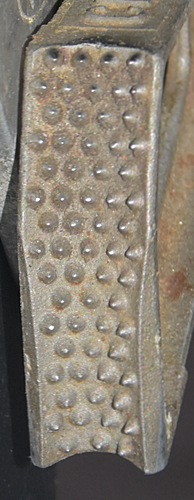 Technical Details
Technical Details
I acquired a right-hand ascender from Brian Trevelyan on eBay in 2005, and a second right-hand ascender from Vanessa Field in 2010.
Version M is 104 mm. high, 82 mm. wide, 25 mm. thick, and weighs 152 grams. The rope channel is 15 mm. wide. The cam axle is centered 55 mm. from the inside of the rope channel. The cam is a skeletonized steel casting with a (4.5)^4(4.3)^4 conical tooth pattern. The teeth axes are perpendicular to the cam face. The cam radius, measured from the pivot, increases from 43 to 57 mm. over an angle of 41°, giving a 22° cam angle. The cam and cam spring are mounted on a semi-tubular rivet. The pivot is centered 55 mm. from the inside of the rope channel. There is no cam safety. The cam is mounted with a bell rivet, which is expanded into a countersunk hole in the shell.
The inner shell surface is stamped with "CLOG" and "WALES inside an oval. The word "CLOG" is cast in the upper cam surface.
This version eliminates the rope size stampings; otherwise, it is identical to Version L
|
 |
I am looking for a left-handed ascender of this version. If you can help me obtain one,
please email me. |
|
[ Top
| Version A
| Versions B1 & B2
| Version C
| Version D
| Version E
| Version F
| Version G
| Version H
| Version I
| Version J
| Version K
]
[ Version L
| Version M
| Version O
| Version P
| Version Q
| Version R
| Version R (2nd)
| Version S
| Version T
| Version U
| Version V
| Return to E.C. Ascenders
]
Version N
(#2122)
Technical Details
 I acquired my Clog, Version N ascenders in 2017 as part of Bob Thrun’s collection.
I acquired my Clog, Version N ascenders in 2017 as part of Bob Thrun’s collection.
The pair consists of a left-handed and a right-handed ascender. Each ascender is 104 mm. tall, 98 mm. wide, 24 mm. thick, and weighs 149 g. The ascender shell is a roughly pentagonal shaped piece of 4 mm. aluminum sheet bent to form a rope groove on one side and to hold the cam pivot on the other. The rope groove is 15 mm. in diameter. The main attachment point is a 16.1 mm. hole located well below the cam pivot. A second 16.1 mm. hole located above the cam serves as an upper attachment point. The cam and cam mounting are the same as on Version K.
The words "CLOG" and "WALES" are stamped inside an ellipse on the inner shell surface. The word "CLOG" is cast in the upper cam surface.
The ascender has better workmanship than earlier versions.
The ascender is excessively wide, with about 25 mm. of width outside the cam rivet serving no useful purpose. I would have reduced the length of the cam channel and changed the angle to make it nearly vertical.
The relocation of the attachment point closer to the rope channel reduces ascender canting under load, thus improving climbing efficiency. The comments on carabiner attachment made above also apply here.
The attachment holes are well rounded, but the top and bottom of the rope groove are not. The sharp edges at these points should be removed prior to use.
[ Top
| Version A
| Versions B1 & B2
| Version C
| Version D
| Version E
| Version F
| Version G
| Version H
| Version I
| Version J
| Version K
]
[ Version L
| Version M
| Version N
| Version P
| Version Q
| Version R
| Version R (2nd)
| Version S
| Version T
| Version U
| Version V
| Return to E.C. Ascenders
]
Version O
(#3, 1963, 2124, 3461, 3634)
Technical Details
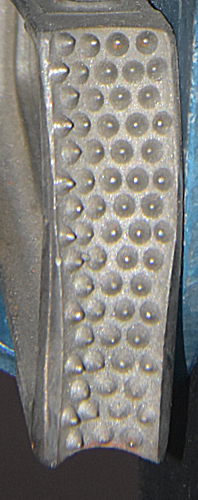 I acquired this pair in 1978 from Ligonier Mountain Outfitters, a right-hand ascender from John Creelman in 2013, and another pair in 2017 as part of Bob Thrun’s collection. On Rope 1 donated a black pair in 2021. I acquired two more blue right-hand ascenders from Colin Ware in 2024, and gave one to Артём Бабин.
I acquired this pair in 1978 from Ligonier Mountain Outfitters, a right-hand ascender from John Creelman in 2013, and another pair in 2017 as part of Bob Thrun’s collection. On Rope 1 donated a black pair in 2021. I acquired two more blue right-hand ascenders from Colin Ware in 2024, and gave one to Артём Бабин.
The pair consists of a left-handed and a right-handed ascender. Each ascender is 104 mm. high, 98 mm. wide, 25 mm. thick, and weighs 148 grams. The ascender shell is a roughly pentagonal shaped piece of blue anodized 3.7 mm. aluminum sheet bent to form a rope groove on one side and to hold the cam pivot on the other. The rope groove is 15.4 mm. in diameter and roughly square in cross section. The main attachment point is a 15.5 mm. hole located well below the cam pivot. A second 15.4 mm. hole located above the cam serves as an upper attachment point. The cam and cam mounting are the same as on Version K.
The word "CLOG" is cast in the upper cam surface.
The anodizing certainly improves the ascenders appearance. Functionally, it is identical to the previous version.
[ Top
| Version A
| Versions B1 & B2
| Version C
| Version D
| Version E
| Version F
| Version G
| Version H
| Version I
| Version J
| Version K
]
[ Version L
| Version M
| Version N
| Version O
| Version Q
| Version R
| Version R (2nd)
| Version S
| Version T
| Version U
| Version V
| Return to E.C. Ascenders
]
Version P
(#2004, 3592)
Technical Details
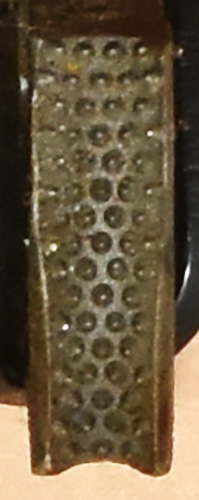 I acquired a left-hand ascender from G. I. Joe Army Stores in 2015 and a pair from Noco Gear in 2023.
I acquired a left-hand ascender from G. I. Joe Army Stores in 2015 and a pair from Noco Gear in 2023.
The pair consists of a left-handed and a right-handed ascender. Each ascender is 104 mm. high, 97 mm. wide, 25 mm. thick, and weighs 158 grams. The ascender shell is a roughly pentagonal shaped piece of blue anodized 4.4 mm. aluminum sheet bent to form a rope groove on one side and to hold the cam pivot on the other. The rope groove is 16.2 mm. in diameter. The main attachment point is a 15.5 mm. hole located well below the cam pivot. A second 15.4 mm. hole located above the cam serves as an upper attachment point. The cam and cam mounting are the same as on Version K.
The word "CLOG" is cast in the upper cam surface. what I believe is a lot number (e.g., "T286" or "T385") is stamped on the lower front of the shell.
The shell is thicker than on the previous version, accounting for the extra weight. Functionally, this version is identical to the previous version.
[ Top
| Version A
| Versions B1 & B2
| Version C
| Version D
| Version E
| Version F
| Version G
| Version H
| Version I
| Version J
| Version K
]
[ Version L
| Version M
| Version N
| Version O
| Version P
| Version Q
| Version R (2nd)
| Version S
| Version T
| Version U
| Version V
| Return to E.C. Ascenders
]
Version R
(#1512, 1904, 1954, 2005)
Technical Details
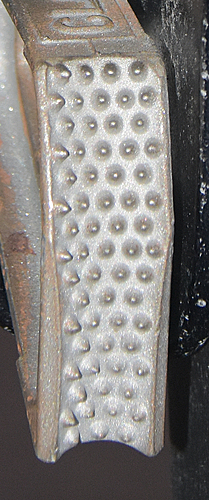 I acquired a left-hand Clog, Version R from Kieron Kent in 2009, a pair from Brittany Jacobs in 2012, a right-hand ascender from John Creelman in 2013, and another right-hand ascender from G. I. Joe Army Stores in 2015.
I acquired a left-hand Clog, Version R from Kieron Kent in 2009, a pair from Brittany Jacobs in 2012, a right-hand ascender from John Creelman in 2013, and another right-hand ascender from G. I. Joe Army Stores in 2015.
Version R is 104 mm. tall, 98 mm. wide, 26 mm. thick, and weighs 157 g. The rope channel is 16 mm. wide. The cam radius increases from 43 to 57 mm. over an angle of 41°, giving a 22° cam angle. The tooth pattern is (4.5)^4(4.3)^4 .
Version R adds a cam stop to the design.
The
word "CLOG" is cast in the upper cam surface.
I don't see any real value in having a cam stop.
The comments on carabiner attachment made above also apply here.
The attachment holes are not rounded, nor are the top and bottom
of the rope groove.
[ Top
| Version A
| Versions B1 & B2
| Version C
| Version D
| Version E
| Version F
| Version G
| Version H
| Version I
| Version J
| Version K
]
[ Version L
| Version M
| Version N
| Version O
| Version P
| Version Q
| Version R
| Version R (2nd)
| Version S
| Version T
| Version V
| Return to E.C. Ascenders
]
Version U
(#233)
Technical Details
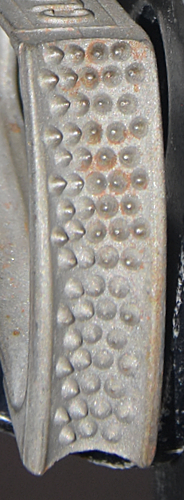 I acquired this ascender from Erica Harley on eBay in 2007.
I acquired this ascender from Erica Harley on eBay in 2007.
My Version U is a left-handed ascender. It is 104 mm. high, 99 mm. wide, 32 mm. thick, and weighs 155 grams. The rope channel is 15 mm. wide. The cam radius increases from 43 to 57 mm. over an angle of 41°, giving a 22° cam angle. The tooth pattern is (4.5)^4(4.3)^4 . There is 6.1 mm. long, 6.4 mm. diameter cam stop riveted to the shell above the cam. There is a 3.1 mm. hole near the base of the cam channel.
The word "CLOG" is cast in the upper cam surface.
The cam stop is a semi-tubular rivet expanded into a countersunk hole in the shell. This does not appear to be a very strong mounting, but it doesn't matter, since the cam stop does not serve a practical purpose.
The hole in the cam channel serves no useful function. It looks like a hole for adding a cam safety like the ones that appear on the Clog Expedition ascender.
|
 |
I am looking for a right-handed ascender of this version. If you can help me obtain one,
please email me. |
|
[ Top
| Version A
| Versions B1 & B2
| Version C
| Version D
| Version E
| Version F
| Version G
| Version H
| Version I
| Version J
| Version K
]
[ Version L
| Version M
| Version N
| Version O
| Version P
| Version Q
| Version R
| Version R (2nd)
| Version S
| Version T
| Version U
| Return to E.C. Ascenders
]
Version V
(#196)
Technical Details
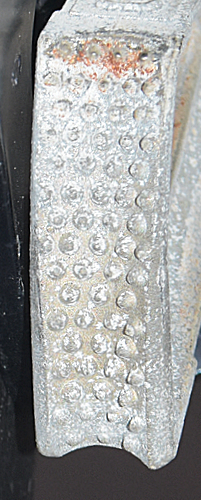 I acquired this ascender from Jim Halstead on eBay in 2005.
I acquired this ascender from Jim Halstead on eBay in 2005.
My Version V is a right-handed ascender. It is 104 mm. high, 99 mm. wide, 32 mm. thick, and weighs 155 grams. The ascender shell similar to the Version O shell, except for color and a second attachment hole below the cam. All three attachment holes are 16.2 mm. in diameter, slightly larger than those on Version O. The cam is identical to the Version K & D cams, but the cam axle is a stainless steel pin, grooved at each end for an retaining ring. A recessed bushing fits on the pin outside the shell, and the retaining ring sits in the recess.
The shell is stamped with a "C." The word "CLOG" is cast in the upper cam surface.
The ascender has the best workmanship of the Clogs discussed here. The cam mounting is better than any of the earlier methods. The pin/bushing/retaining ring combination makes a semi-permanent mounting that can be disassembled, but not without careful effort.
Like Version O, Version V is excessively wide. The comments on carabiner attachment made above also apply here. The attachment holes are not rounded, nor are the top and bottom of the rope groove. The sharp edges at these points should be removed prior to use.
|
 |
I am looking for a left-handed ascender of this version. If you can help me obtain one,
please email me. |
|
[ Top
| Version A
| Versions B1 & B2
| Version C
| Version D
| Version E
| Version F
| Version G
| Version H
| Version I
| Version J
| Version K
]
[ Version L
| Version M
| Version N
| Version O
| Version P
| Version Q
| Version R
| Version R (2nd)
| Version S
| Version T
| Version U
| Version V
]


